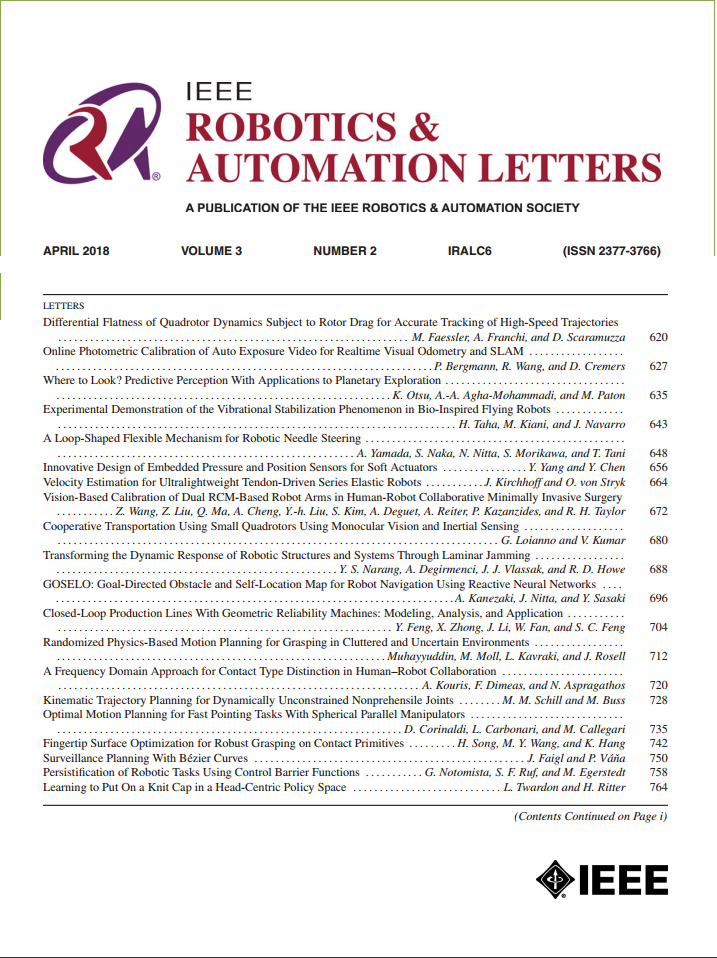Using Mobile AR for Rapid Feasibility Analysis for Deployment of Robots: A Usability Study With Non-Expert Users
IF 4.6
2区 计算机科学
Q2 ROBOTICS
引用次数: 0
Abstract
Automating a production line with robotic arms is a complex, demanding task that requires not only substantial resources but also a deep understanding of the automated processes and available technologies and tools. Expert integrators must consider factors such as placement, payload, and robot reach requirements to determine the feasibility of automation. Ideally, such considerations are based on a detailed digital simulation developed before any hardware is deployed. However, this process is often time-consuming and challenging. To simplify these processes, we introduce a much simpler method for the feasibility analysis of robotic arms' reachability, designed for non-experts. We implement this method through a mobile, sensing-based prototype tool. The two-step experimental evaluation included the expert user study results, which helped us identify the difficulty levels of various deployment scenarios and refine the initial prototype. The results of the subsequent quantitative study with 22 non-expert participants utilizing both scenarios indicate that users could complete both simple and complex feasibility analyses in under ten minutes, exhibiting similar cognitive loads and high engagement. Overall, the results suggest that the tool was well-received and rated as highly usable, thereby showing a new path for changing the ease of feasibility analysis for automation.使用移动AR进行机器人部署的快速可行性分析:非专业用户的可用性研究
用机械臂自动化生产线是一项复杂而苛刻的任务,不仅需要大量的资源,还需要对自动化过程和可用技术和工具的深刻理解。专家集成商必须考虑诸如位置、有效载荷和机器人到达要求等因素,以确定自动化的可行性。理想情况下,这些考虑是基于在部署任何硬件之前开发的详细数字模拟。然而,这个过程通常是耗时且具有挑战性的。为了简化这些过程,我们引入了一种为非专家设计的更简单的机械臂可达性可行性分析方法。我们通过一个移动的、基于传感的原型工具来实现这个方法。两步实验评估包括专家用户研究结果,这有助于我们确定各种部署场景的难度级别,并完善初始原型。随后对22名非专业参与者进行的定量研究结果表明,用户可以在10分钟内完成简单和复杂的可行性分析,表现出相似的认知负荷和高参与度。总的来说,结果表明该工具是很受欢迎的,并且被评为高度可用性,从而为改变自动化可行性分析的便利性显示了一条新的途径。
本文章由计算机程序翻译,如有差异,请以英文原文为准。
求助全文
约1分钟内获得全文
求助全文
来源期刊

IEEE Robotics and Automation Letters
Computer Science-Computer Science Applications
CiteScore
9.60
自引率
15.40%
发文量
1428
期刊介绍:
The scope of this journal is to publish peer-reviewed articles that provide a timely and concise account of innovative research ideas and application results, reporting significant theoretical findings and application case studies in areas of robotics and automation.
 求助内容:
求助内容: 应助结果提醒方式:
应助结果提醒方式:


